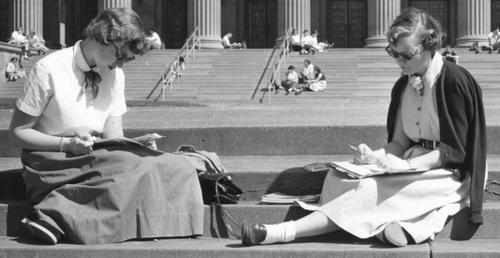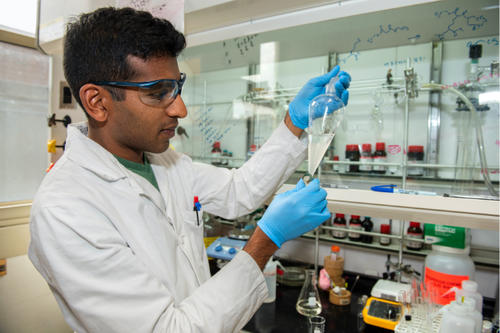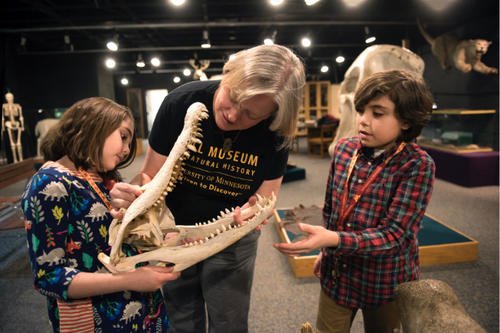1851-1900: The Early Years
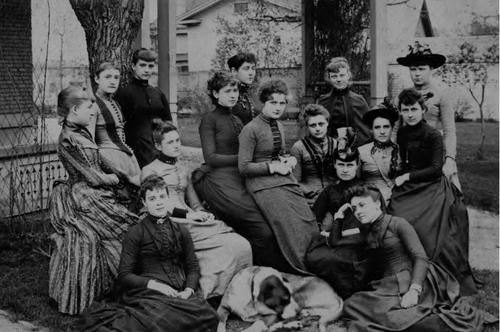
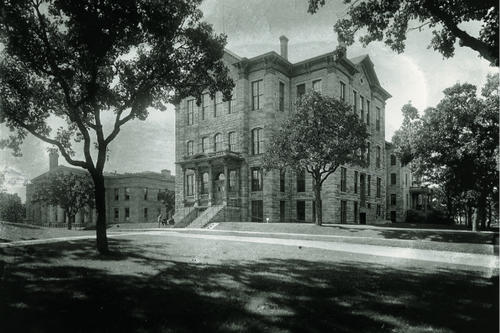
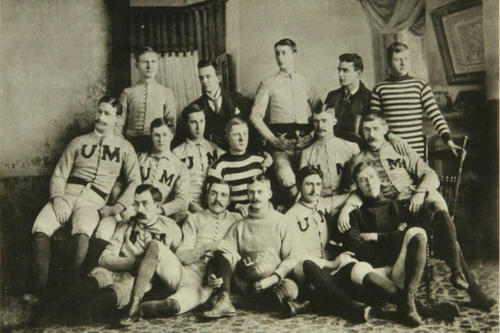
Minnesota Territorial Legislature and Gov. Alexander Ramsey charter the University of Minnesota and elect a board of regents, seven years before Minnesota becomes a state.
Old Main, the U of M’s first permanent building, is erected on the Historic Knoll Area of campus.
The University temporarily closes during the Civil War.
Morrill Land-Grant Colleges Act signed, establishing federal land-grant resources for schools that teach and research agriculture and mechanic arts.
Regent John Sargent Pillsbury reopens Old Main and the U of M resumes operations.
Warren Clark Eustis and Henry Martyn Williamson are the first graduates.
Helen Marr Ely is the first female graduate.
Maria Sanford is hired as the first woman professor.
First master’s degree awarded.
Sale of agricultural land in Minneapolis and acquisition of land in St. Paul for the U’s experimental farm.
Hatch Act launches nation’s agricultural experiment stations, supporting research as a primary mission of U’s College of Agriculture.
First PhD degree is awarded, one of the first in the nation.
Cheerleading originates nationwide at the University of Minnesota when John E. Campbell organizes unified cheers in a football game against Northwestern. The Gophers won, and a cherished tradition was born.
The Minnesota Daily begins publication.
1901-1960: The Campus Takes Shape
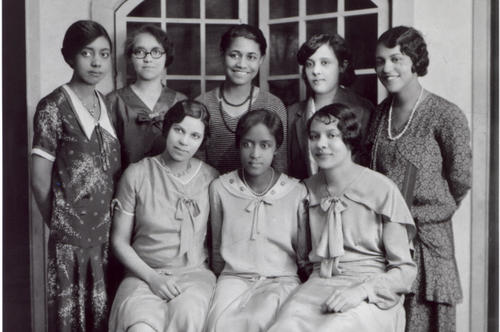
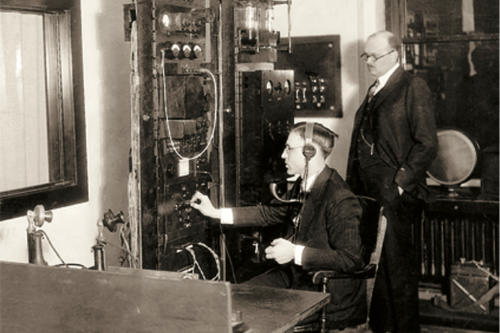
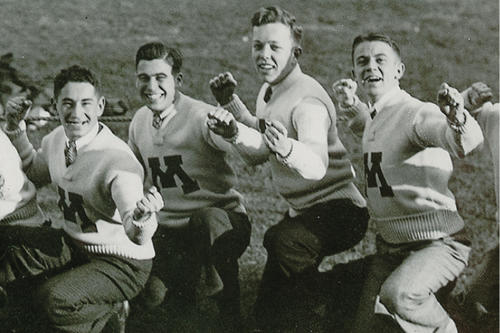
Alumni Association founded.
Fire destroys Old Main.
Snapshot in time: Tuition is $10 per semester.
School of Forestry establishes field station at Itasca State Park.
The Program of Mortuary Science at the U of M becomes the first program of its kind to be organized at a state university in the U.S.
The U of M’s School of Nursing begins. It’s the first continuing nursing school on a university campus in the United States. (Men weren’t admitted to the program until 1949).
The U of M Rouser debuts. Judges select Floyd Hutsell’s song after a statewide contest for a spirited song to represent the U of M at sporting events. Most of the verses are forgotten, but the catchy refrain lives on, 110 years later.
Digitalis is grown and prepared on campus by the College of Pharmacy for treating fever and hypertension in WWI soldiers.
The Gophers play their first basketball game at Williams Arena, losing 42-40 to Ohio. James Naismith—the inventor of basketball—was in attendance, and a reserved seat cost 35 cents.
Izaak Maurits Kolthoff, widely considered the father of analytical chemistry, makes major contributions to the development of synthetic rubber during WWII.
Physics professor Alfred O. C. Nier isolates U235 as responsible for slow fission in uranium, ushering in the atomic age.
Running back Bruce Smith becomes the only Golden Gopher (so far) to win the Heisman trophy. He delivered a moving Heisman acceptance speech right after the attack on Pearl Harbor. The following year he starred in a movie about himself titled Smith of Minnesota.
Professor Edward Wilson Davis develops the first of many processes for converting taconite rock into commercial iron ore.
St. Anthony Falls Hydraulic Laboratory is founded, establishing the U of M as a world leader in water resources and hydraulic research.
James “Crash” Ryan, a researcher in the Department of Engineering, proves the effectiveness of seat belts in reducing injuries from car crashes and in 1963 obtains a patent for the retractable seat belt. (Ryan also develops the “black box” flight recorder.)
C. Walton Lillehei and F. John Lewis perform the world’s first open-heart surgery using cross-circulation at the University of Minnesota.
Richard DeWall and C. Walton Lillehei develop the bubble oxygenator, the prototype for today’s heart-lung machine.
Walter Brattain is joint winner of the Nobel Prize in physics for discovering the transistor effect.
C. Walton Lillehei performs the world’s first artificial heart valve implant in a human.
Earl Bakken, cofounder of Medtronic, Inc., invents the world’s first portable pacemaker at the request of C. Walton Lillehei, who is the first to use it in a patient.
The U of M Landscape Arboretum—a public learning and demonstration area and horticulture laboratory—is established in Chanhassen.
Robert Zimmerman enrolls at the U of M but spends most of his time playing his guitar and singing at local coffeehouses. He soon drops out, moves to New York, and becomes a legend of folk music under the name of Bob Dylan.
The antifibrillation heart drug bretylium is developed to save the lives of heart attack victims.
1961-2000: Growth and Innovation
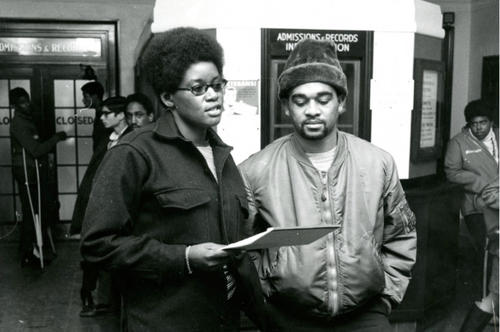

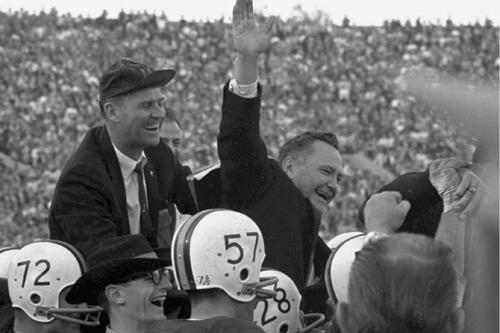
The Twin Cities campus crosses the river with construction of the Washington Avenue Bridge and the first buildings on the West Bank.
U of M cancels classes when 14 inches of snow blanket the Twin Cities. This is the first known snow day in the University’s history!
The world’s first successful kidney/pancreas transplant is performed at the U of M.
The world’s first successful bone marrow transplant is performed at the U of M.
The Department of American Indian Studies is established as the first of its kind at a U.S. university.
The African American Studies department is created.
U of M alum Norman Borlaug wins the Nobel Peace Prize for contributions to the “Green Revolution” in the 1960s, including developing new wheat varieties aimed at better feeding the world’s hungry.
The Office of Equal Opportunity and Affirmative Action is established.
Dominick Argento wins the Pulitzer Prize in music for Diary of Virginia Woolf.
The U of M was the first American university to acquire a supercomputer (a Cray-1).
U of M microbiologist Russell Johnson identifies the pathogen that causes Lyme disease and, in 1988, patents a vaccine for dogs.
U apple breeders release the Honeycrisp apple, which goes on to become a favorite around the country and the state fruit of Minnesota.
The Frederick R. Weisman Art Museum, designed by Frank Gehry, opens to house U of M art collections.
The world’s first living donor pancreas transplant is performed at the U of M.
The Stem Cell Institute is established as the world’s first interdisciplinary institute dedicated to stem cell research.
Notable Alumni
Arts
- Maria Bamford
Stand-up comedian and actress
- Lou Bellamy
Founder of Penumbra Theater in St. Paul
- Endesha Mae Holland
Scholar, playwright, and civil rights activist
- Elizabeth “Libby” Larsen
Award-winning composer and Grammy award winner
- Maria Schneider
Grammy-winning composer and jazz orchestra leader
- Cheryl Strayed
Author of No. 1 bestselling memoir Wild
- Dessa Wander
Renowned Minnesota rapper and author
Business
- Earl Bakken
Founder of Medtronic
- Curt Carlson
Founder of Gold Bond Stamp Company and Carlson Companies
- Arthur Fry
Co-creator of Post-It Notes
Food and Agriculture
- Sarah C. Bisel
International expert on ancient health and nutrition
- Norman Borlaug
Winner of Nobel Peace Prize and Father of the Green Revolution
Journalism
- Annie Griffiths
One of first women photographers for National Geographic
- Michele Norris
First African American female host for NPR
- Judy Olausen
World-renowned photographer
- Harrison E. Salisbury
Pulitzer Prize-winning journalist and author of 29 books
- Eric Sevareid
Author and longtime CBS news journalist
Law
- Alan Page
NFL Hall of Famer and Minnesota Supreme Court Justice
- McCants Stewart
First African American admitted to the Oregon state bar
Medicine
- Eduardo Santiago Delpin
Author of first book in Spanish about organ transplants
- F. John Lewis
Surgeon for first successful open-heart operation
- Norman Shumway
Surgeon who performed the world’s first heart-lung transplant
Politics and Policy
- Helen J. Claytor
Civil rights worker and president of the national YWCA
- Robert Traynham Coles
Cofounder of U of M’s NAACP chapter
- Keith Ellison
Congressman and Minnesota Attorney General
- Hubert H. Humphrey
Longtime statesman and Vice President of the United States
- Walter Mondale
42nd Vice President of the United States
- Carl Stokes
First black mayor of a major U.S. city (Cleveland)
- Sarah Susanka
Originator of the small-house movement
- Anton Treuer
Author specializing in Ojibwe language and American Indian Studies
- Frank Wheaton
First African American to serve in the Minnesota State Legislature
- Roy Wilkins
Executive director of the NAACP
- Whitney Young
Presidential advisor and recipient of the Presidential Medal of Freedom
Science and Technology
- Melvin Calvin
Nobel Prize in Chemistry
- Seymour Cray
“The father of supercomputing”
- Reynold B. Johnson
Computer pioneer said to be the “father” of the hard disk drive
- Ernest O. Lawrence
Nuclear scientist and winner of the Nobel Prize in Physics
- Raymond L. Lindeman
Early leader in the field of ecosystem ecology
- Kaworu “Carl” Nomura
Inventor of auto ignition system and auto focus on cameras
- Jeanette Piccard
Balloonist and first woman in space
- Donald “Deke” Slayton
One of the original NASA Mercury Seven astronauts
Sports
- Bobby Bell
Hall of Fame football player
- Herb Brooks
Head coach of Gopher men’s hockey team and “Miracle on Ice” Olympic team
- Tony Dungy
Super Bowl-winning NFL player and head coach
- Tom Lehman
Former No. 1-ranked professional golfer
- Alan Page
NFL Hall of Famer and Minnesota Supreme Court Justice
- Lindsay Whalen
WNBA and Olympic champion and head coach of Gopher women’s basketball team
